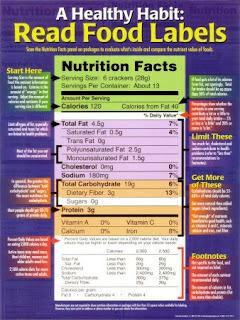Make the serving sizes realistic. Some of the serving sizes are extraordinarily underestimated and can me misleading to consumers. Christopher Gardner, a nutrition scientist at the Stanford Prevention Research Center, suggests that if the package were given to any number of individuals, the serving size should reflect what the average person actually ate. (The average person almost always eats more). Another nutritionalist named Heather Bauer suggested that the serving sizes should be in ounces instead of grams.
Have caffeine content listed. Caffeine is found in many products like soda and chocolate as well as some products you may not expect, like some ice creams. This is crucial because many people are sensitive to even small amounts, says s nutrition performance coach Tara Gidus, a nutrition performance coach. It is also important that the amount of articial sweeteners and colorings are listed.
Better explain the percentage daily value. Make clear, for example, if a food has 20 percent of the recommended DV of saturated fat, you don’t need to eat more at another meal to get up to the 100 percent level; that DV is a maximum recommendation. For vitamins and minerals, the recommended daily value is a minimum, which means you’ll need to get the whole amount during the day. In addition, those recommendations are based on a 2,000-calorie diet for adults, which may be too much for people trying to lose weight and doesn’t apply to growing adolescents, says Sari Greaves, a dietitian.
Give a percentage daily value for sugar. There should be a reccomended sugar intake. It is also recommend that the total sugar content should be subdivided into added sugars, such as high-fructose corn syrup, and naturally sugars, from whole foods like fruit.
Make it simple with color-coding or scores. Food labels could include a star rating system to indicate whether the food has more or fewer healthy characteristics (high in fiber, lower in sugar, high in omega-3s, low fat, etc.), says nutritionist Gardner.
Include a list of healthy pairings with the product. On a cereal label, pairings could include skim milk, a banana, berries, nuts, seeds, presumably foods that make a balanced and wholesome meal.
Give more information about whole grains and real fruits. The amount of whole grains in a product can be difficult to understand. Nutritionalists recommended the amount in grams and percentage of the food be added. Also, if a product’s name mentions fruit, its label should tell exactly how much is really fruit and if there are any preservatives.

All these would be really great changes...love the color-coding idea :)
ReplyDeleteI just hope some of these suggestions are actually implemented :)
ReplyDeleteHi Vanessa,
ReplyDeleteReal nice recipes, enjoy and pass it on to my home. Like your blog, featured it on mine :
http://africasiaeuro.blogspot.com/2010/07/vanessas-soda-fountain.html
also on our Networked Blog (appreciate follow back, thanks :)
http://apps.facebook.com/blognetworks/blog/the_mindwanderer/
http://apps.facebook.com/blognetworks/blog/work_travel_live